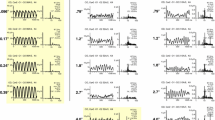Abstract
Purpose
To assess if conversion of decimal visual acuity (VA) to logMAR is reliable for clinical and research purposes.
Methods
Right eye VA of 74 consecutive patients was measured with 5 min interval, using (a) the ETDRS chart (VAlog), (b) a decimal chart at 6 m (VA6m), and (c) a decimal chart at 4 m (VA4m). VA was the smallest line whereby four of five optotypes were correctly identified. Decimal scores were converted to logMAR using the formula logMAR = −log(decimal acuity). The agreement between VAlog, VA4m, and VA6m was assessed by the Bland-Altman method.
Results
Linear regression analysis of the difference between VAlog and VA6m or VA4m showed a significant slope (p = 0.001), with greater disagreement at higher VA values, i.e., poorer acuity. There was considerable lack of agreement, with discrepancies of up to 0.2 logMAR when VA was measured around 0.5 logMAR.
Conclusion
Converting decimal VA to logMAR produces overestimation of its true value, especially in lower acuities.



Similar content being viewed by others
References
Moutray TN, Williams MA, Jackson AJ (2008) Change of visual acuity recording methods in clinical studies across the years. Ophthalmologica 222:173–177
Chew EY, Lindblad AS, Clemons T (2009) Age-related eye disease study research group. Summary results and recommendations from the age-related eye disease study. Arch Ophthalmol 127(12):1678–1679
Bailey IL, Lovie JE (1976) New design principles for visual acuity letter charts. Am J Optom Physiol 53(11):740–745
Lovie-Kitchin JE (2015) Is it time to confine Snellen charts to the annals of history? Ophthalmic Physiol Opt 35:631–636
Paliaga GP (2006) Some remarks on the precision of visual acuity measurements. Klin Monatsbl Augenheilkd 223(1):18–23
Williams MA, Moutray TN, Jackson AJ (2008) Uniformity of visual acuity measures in published studies. Invest Ophthalmol Vis Sci 49:4321–4327
Patel H, Congdon N, Strauss G, Lansingh C (2017) A need for standardization in visual acuity measurement. Arq Bras Oftalmol 80(5):332–337
Plainis S, Tzatzala P, Orphanos Y, Tsilimbaris MK (2007) A modified ETDRS visual acuity chart for European-wide use. Optom Vis Sci 84(7):647–653
Holladay JT (2004) Visual acuity measurements. J Cataract Refract Surg 30(2):287–290
Bland JM, Altman DG (1999) Measuring agreement in method comparison studies. Stat Methods Med Res 8:135–160
Beck RW, Moke PS, Turpin AH et al (2003) A computerized method of visual acuity testing: adaptation of the Early Treatment of Diabetic Retinopathy Study testing protocol. Am J Ophthalmol 135:194–205
Bailey IL, Lovie-Kitchin JE (2013) Visual acuity testing. From the laboratory to the clinic. Vis Res 90:2–9
NAS-NRC Committee on vision (1980) Recommended standard procedures for the clinical measurement and specification of visual acuity. Adv Ophthalmol 41:103
Shah N, Dakin SC, Whitaker HL, Anderson RS (2014) Effect of scoring and termination rules on test-retest variability of a novel high-pass letter acuity chart. Invest Ophthalmol Vis Sci 55(3):1386–1392
Kaiser PK (2009) Prospective evaluation of visual acuity assessment: a comparison of Snellen versus ETDRS charts in clinical practice (an AOS thesis). Trans Am Ophthalmol Soc 107:311–324
Author information
Authors and Affiliations
Corresponding author
Ethics declarations
Conflict of interest
Author Asimina Mataftsi declares that she has no conflict of interest.
Author Dimitrios Koutsimpogeorgos declares that he has no conflict of interest.
Author Nikolaos Ziakas declares that he has no conflict of interest.
Author Periklis Brazitikos declared that he had no conflict of interest.
Author Anna-Bettina Haidich declares that she that has no conflict of interest.
Ethical approval
All procedures performed in this study involving human participants were in accordance with the ethical standards of the institutional research committee and with the 1964 Helsinki declaration and its later amendments or comparable ethical standards.
Informed consent
Informed consent was obtained from all individual participants included in the study.
Additional information
Publisher’s note
Springer Nature remains neutral with regard to jurisdictional claims in published maps and institutional affiliations.
Rights and permissions
About this article
Cite this article
Mataftsi, A., Koutsimpogeorgos, D., Brazitikos, P. et al. Is conversion of decimal visual acuity measurements to logMAR values reliable?. Graefes Arch Clin Exp Ophthalmol 257, 1513–1517 (2019). https://doi.org/10.1007/s00417-019-04344-9
Received:
Revised:
Accepted:
Published:
Issue Date:
DOI: https://doi.org/10.1007/s00417-019-04344-9




